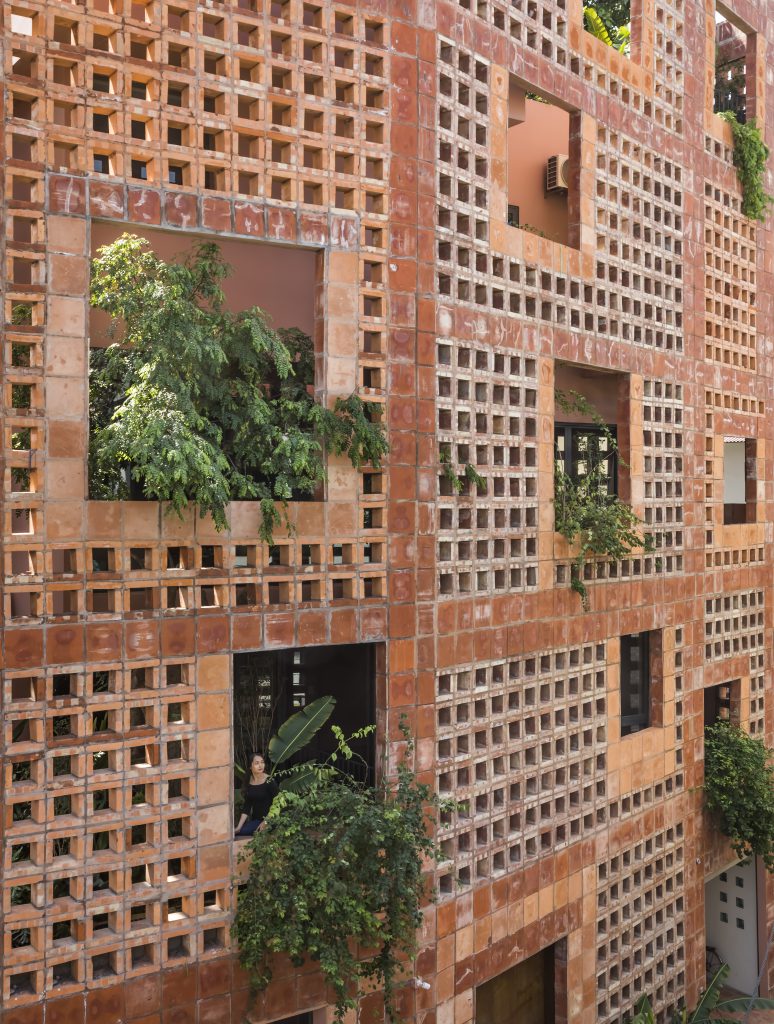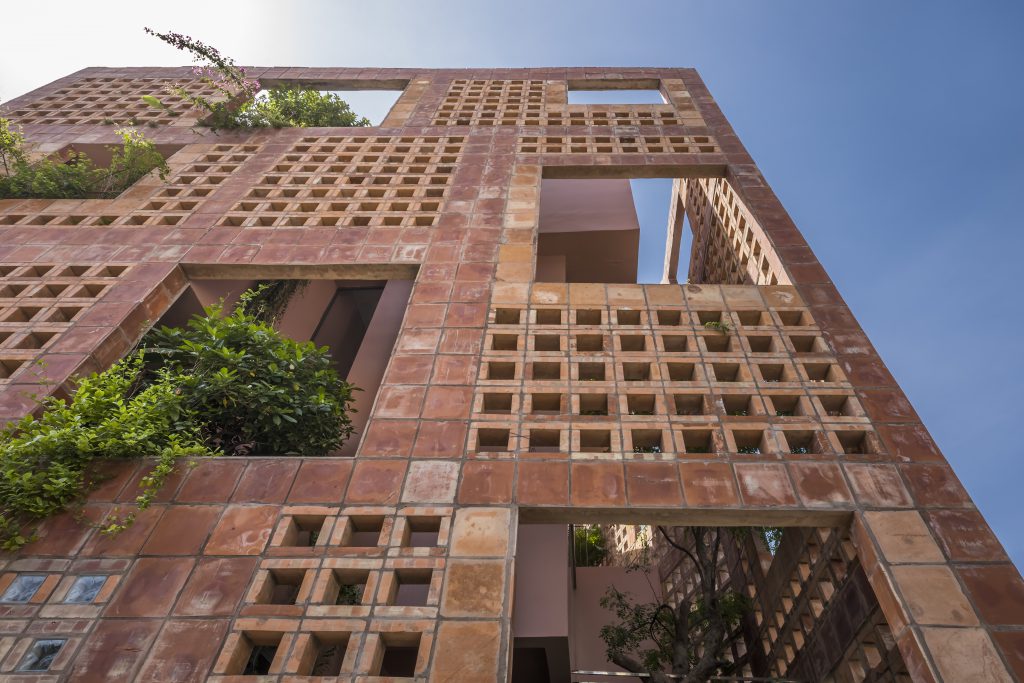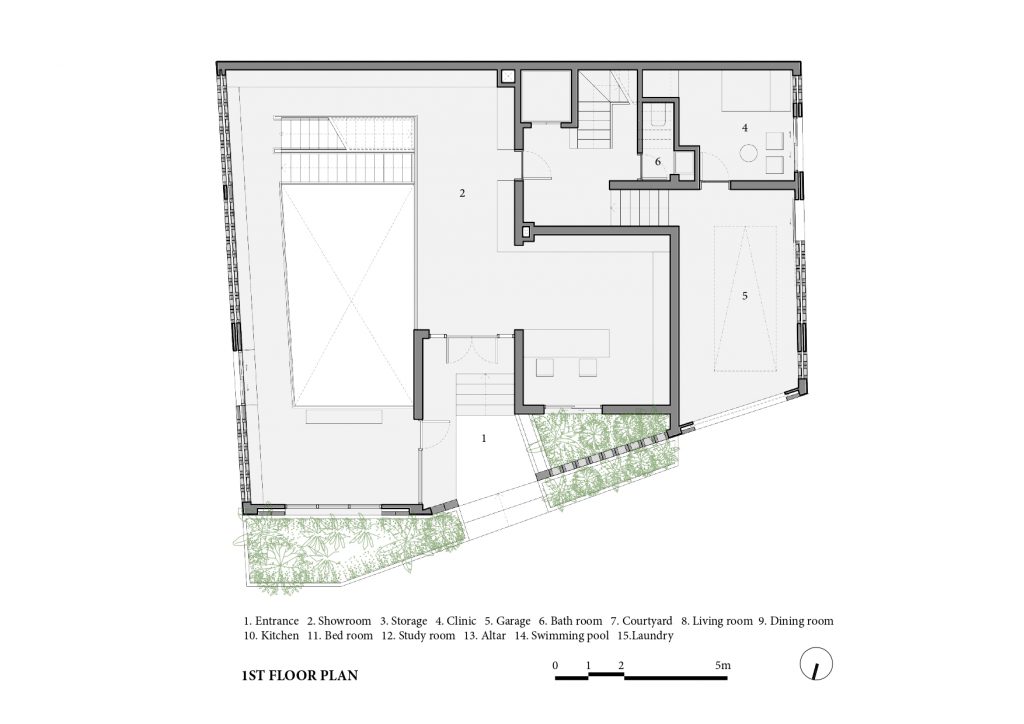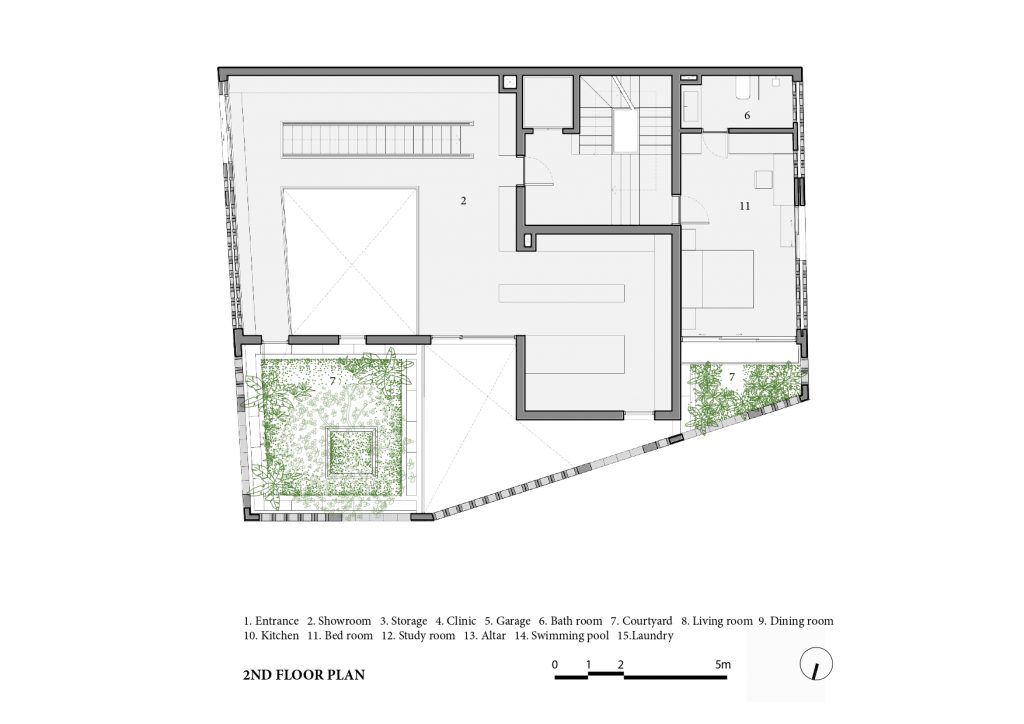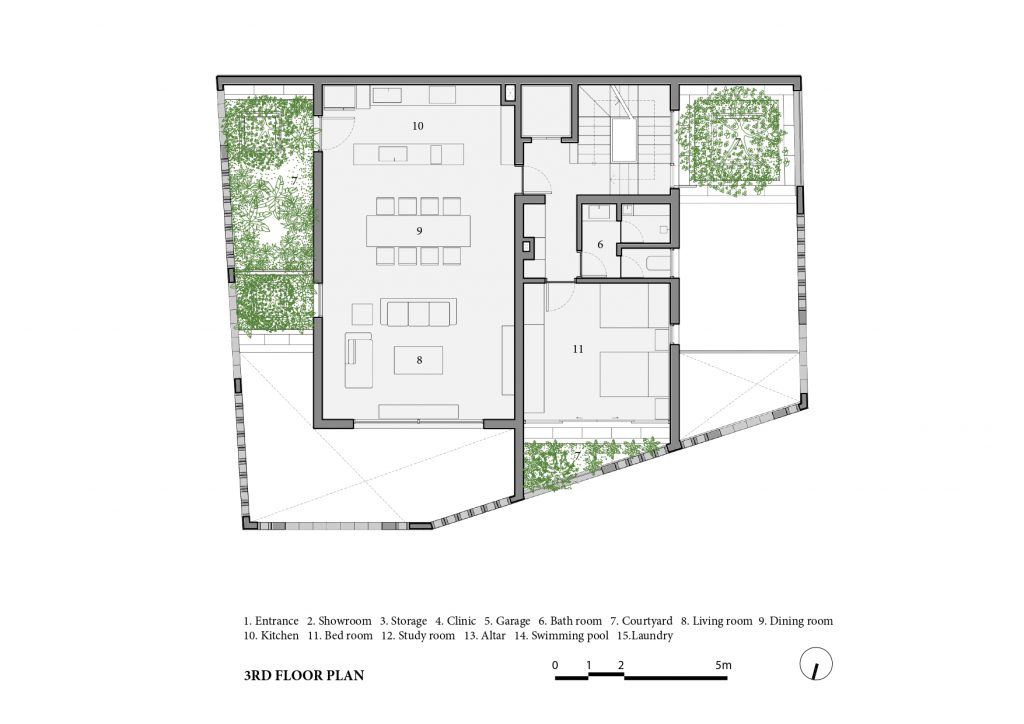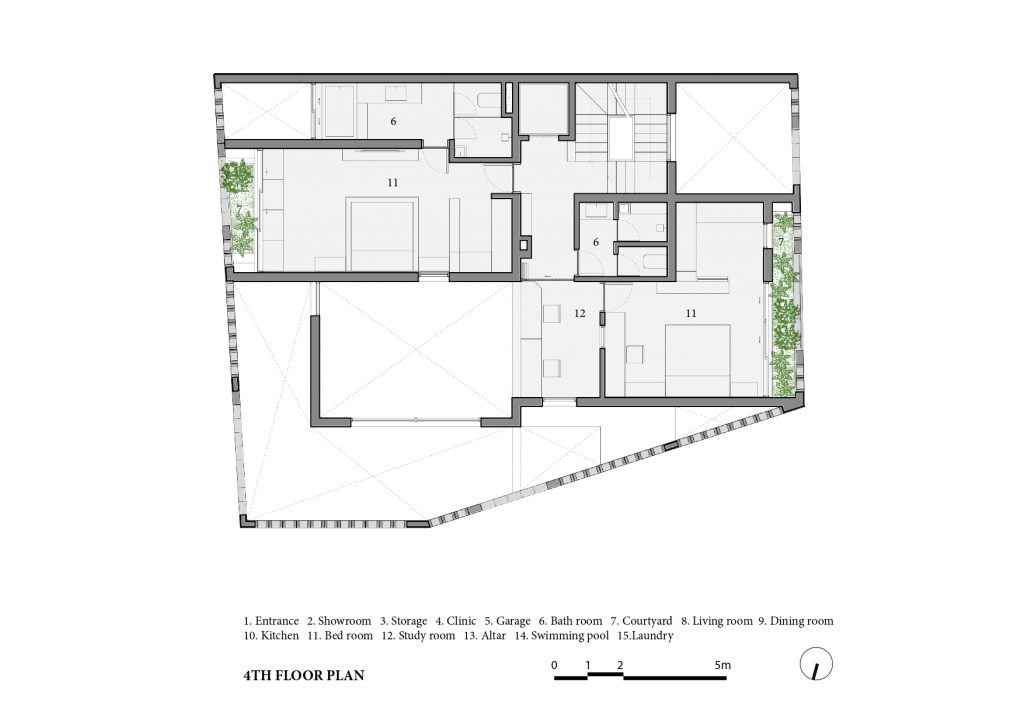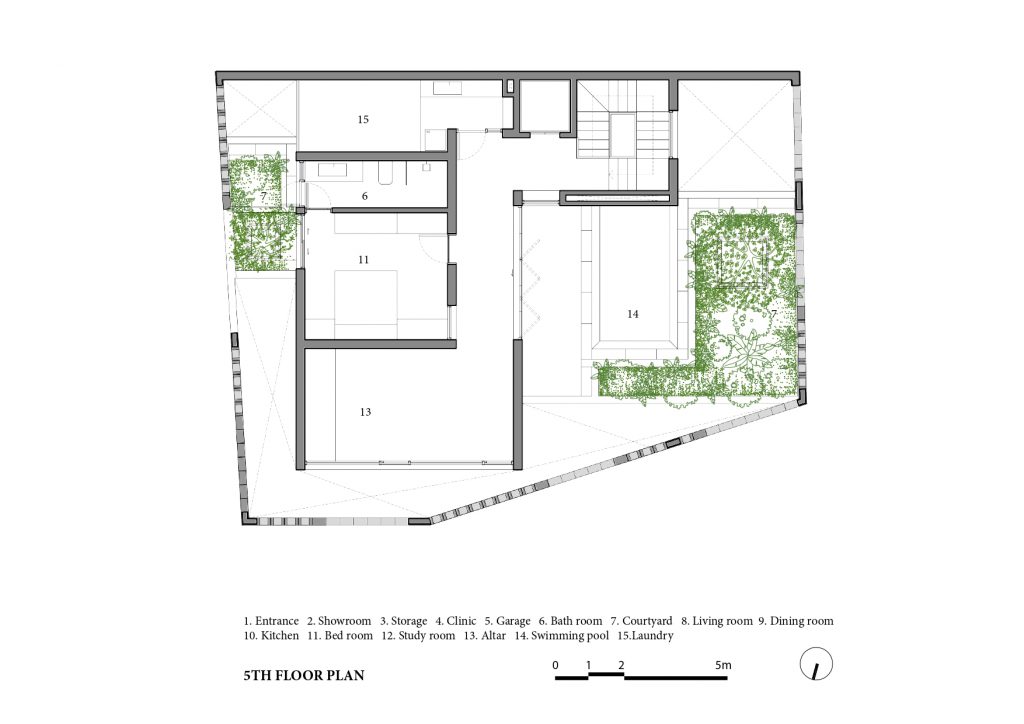In the Bat Trang Village near Hanoi, Vo Trong Nghia Architects has designed a new house that demonstrated an intelligent way for a home to coexist with the city and nature.
Text: Supreeya Wungpatcharapon
Photo Courtesy of Vo Trong Nghia Architects and Horiyu Oki except as noted
Download the online journal Issue 05 Home Smart Home Click here

วัสดุธรรมชาติและต้นไม้ เป็นองค์ประกอบที่โดดเด่นในผลงานเกือบทุกชิ้นของบริษัทสถาปนิกเวียดนาม Vo Trong Nghia Architects โดยเฉพาะงานประเภทที่อยู่อาศัย อย่างที่เราคงรู้จักกันดีในผลงานชุด House for Trees หลายหลัง และในขณะที่ไม้ไผ่ดูจะเป็นวัสดุที่เขาเลือกใช้บ่อยครั้งด้วยกรรมวิธีการสร้างในรูปแบบต่างๆ กันในหลายงาน แต่เป็นครั้งแรกที่เขาเลือกใช้เซรามิคเป็นวัสดุเปลือกอาคารสำหรับการออกแบบบ้าน Bat Trang หลังนี้ ด้วยทำเลที่ตั้งของโครงการในหมู่บ้าน Bat Trang ในเวียดนาม ห่างจากเมืองฮานอยประมาณ 15 กิโลเมตร ซึ่งเป็นแหล่งผลิตเครื่องปั้นเซรามิคมากว่าศตวรรษ และเรื่องราวของครอบครัว เจ้าของบ้านที่ประสบความสำเร็จกับธุรกิจส่งออกเซรามิคไปญี่ปุ่นและยุโรปมาตั้งแต่รุ่นบรรพบุรุษ จึงเป็นที่มาของแรงบันดาลใจให้กับทีมสถาปนิกในการออกแบบบ้านหลังนี้ให้ฉลาด ที่จะอยู่ร่วมกับเมืองและธรรมชาติ
อาคารพาณิชย์หรือตึกแถว องค์ประกอบที่คุ้นตาของเมืองต่างๆ ในภูมิภาคเอเชียตะวันออกเฉียงใต้ด้วยการใช้สอยเพื่อตอบสนองด้านการค้าและการอยู่อาศัยในอาคารเดียวกัน และมักจะออกแบบด้วยรูปแบบทั่วไปที่แบ่งส่วนด้านหน้าเป็นพื้นที่ค้าขายและส่วนหลังของอาคารแยกเป็นส่วนที่อยู่อาศัยอย่างชัดเจนนั้น แต่ในเวียดนามมีการปรับผังพื้นแยกพื้นที่ทั้งสองส่วนแทนด้วย ระดับชั้นของอาคารมาตั้งแต่ช่วงศตวรรษที่ 19 จากโจทย์ความต้องการของธุรกิจเจ้าของโครงการ พื้นที่ชั้นแรกและชั้นใต้ดินของอาคารตึกแถว Bat Trang House หลังนี้จึงเปิดเป็นพื้นที่โชว์รูมร้านเครื่องปั้นเซรามิคของครอบครัว
ส่วนพื้นที่อีกสี่ชั้นด้านบนเป็นส่วนพักอาศัยที่ประกอบด้วย 5 ห้องนอน ส่วนห้องครัว ห้องน้ำ และพื้นที่นั่งเล่นพบปะสังสรรค์ของสมาชิกครอบครัวทั้ง 7 คน ในส่วนชั้นบนสุดเป็นสระว่ายน้ำกลางแจ้ง และห้องวางแท่นบูชาบรรพบุรุษที่ขาดไปไม่ได้สำหรับลายเซ็นการออกแบบโดยสถาปนิก Vo Trong Nghia คือ การสร้างความสัมพันธ์ของการอยู่อาศัยกับธรรมชาติ โดยสอดแทรกพื้นที่ปลูกต้นไม้จริงๆ ไปในบ้านพักอาศัยที่เป็นสิ่งที่ทั้งตัวเขาและครอบครัวเจ้าของบ้านหลังนี้ต่างชื่นชอบเหมือนกัน แม้จะด้วยหลักคิดใหญ่เดียวกันนี้ แต่ Vo Trong Nghia Architects มีเทคนิคการออกแบบที่หลากหลาย ต่างกันไป ในซีรีย์การออกแบบบ้านพักอาศัย House for Trees อย่างบ้าน Stacking Green (2011) ที่ซ้อนชั้นวางต้นไม้โชว์เป็นเปลือกอาคาร หรือ Pot Plant House (2014) ในเมืองโฮจิมินห์ ซึ่งสร้างบนขนาดที่ดินจำกัด การออกแบบตัวบ้านจึงเปรียบเสมือนกระถางไม้ไผ่ที่ปลูกต้นไม้อยู่ด้านบน หลังคาบ้านแทน สำหรับอาคารพาณิชย์ในเมือง Bat Trang หลังนี้อาจมีวิธีการออกแบบที่คล้ายคลึงกับบ้าน Ha Long Villa ที่สร้างเสร็จก่อนในปีเดียวกันด้วยพื้นที่สีเขียวที่แทรกอยู่ช่องว่างตรงกลางระหว่างผนังชั้นนอก และขอบเขตพื้นที่อยู่อาศัยภายใน แต่แตกต่างกันในด้านรายละเอียดโปรแกรมพื้นที่ใช้สอย และวัสดุเปลือกอาคาร
สวนลอยทางตั้งในระดับต่างๆของบ้าน Bat Trang ถูกออกแบบให้สอดแทรกลงไปในช่องว่าง ระหว่างบ้านและผนังก่อเซรามิคที่สร้างมาเป็นเปลือกห่อหุ้มพื้นที่ภายในไว้อีกชั้นหนึ่ง นอกจากจะเป็นการป้องกันแสงแดดและสภาพอากาศภายนอกแล้วนั้น นับว่าเป็นการออกแบบที่ช่วยสะท้อนบริบทท้องถิ่นอีกด้วย เพราะเซรามิคเหล่านี้ออกแบบขนาดและสั่งทำพิเศษในหมู่บ้าน ด้วยขนาดที่ไม่เท่ากัน เมื่อนำมาก่อปิดทึบและเปิดสลับกันไปเป็นช่องว่างในพื้นที่ใช้สอยส่วนต่างๆ ทำให้เกิดรูปแบบของผนังภายนอกอาคารที่เฉพาะตัว ช่วยสร้างปฏิสัมพันธ์ภายนอกภายในอาคาร ระหว่างบ้านพักอาศัยส่วนตัวกับเมืองและผู้คนโดยรอบในระดับต่างๆ นอกจากนี้เซรามิคยังมีความทนทานสูง ให้สีและพื้นผิวสวยงามดิบๆ แบบธรรมชาติ

นอกจากนี้ทีมสถาปนิกยังให้ความสำคัญกับหลักการออกแบบด้วย Passive design ที่เปิดให้แสงและลมธรรมชาติผ่านเข้ามาสร้างความน่าสบายในอาคารและเพื่อการประหยัดพลังงาน ดังเช่นในผลงานทุกชิ้นที่ผ่านมา ผังพื้นภายในของบ้านจึงถูกออกแบบด้วยวิธีการที่เรียบง่าย มีการใช้แผงกระจกขนาดใหญ่สำหรับกรอบของผนังบ้านชั้นในโดยไม่ต้องกลัวว่าบ้านจะร้อนจนเกินไป เนื่องจากแสงแดดโดยตรงนั้นถูกกรองโดยผนังก่อในชั้นนอก และพื้นที่สีเขียวที่เป็นช่องโล่งว่างระหว่างกรอบผนังทางตั้งนี้ทํางานได้ดีเป็นพิเศษในแง่ของการกรองแสงอาทิตย์ให้เข้ามาในปริมาณที่เหมาะสมในพื้นที่ภายในบ้านโดยเฉพาะอย่างยิ่งในฤดูร้อน ทำให้การใช้เครื่องปรับอากาศจึงแทบไม่จําเป็น เนื่องจากสถาปนิกออกแบบให้มีระบบระบายอากาศสามชั้น คือ “ผนังก่อเซรามิกภายนอก” สลับกับ “พื้นที่สวนทางตั้ง” และ “ประตู” เป็นกรอบให้กับพื้นที่ใช้สอยภายในอีกชั้นหนึ่ง จึงค่อนข้างเชื่อมั่นได้ว่าบ้านจะเย็นอย่างแน่นอน นอกจากนี้ยังมีการติดตั้งแผงโซลาร์เซลล์และที่เก็บกักน้ำฝนเพื่อการนำกลับมาใช้ใหม่เป็นส่วนหนึ่งของการออกแบบที่ยั่งยืน
ช่องหน้าต่างบานใหญ่สลับกับช่องเปิดโล่งจากผนังก่อเซรามิคที่เชื่อมต่อกัน แทรกด้วยพื้นที่สวนในร่ม ยังช่วยสร้างกรอบรูปที่มีชีวิตหลายระดับชั้น แตกต่างกันไปในแต่ละระดับและส่วนของพื้นที่ใช้สอยภายใน ซึ่งจะมีการเปลี่ยนแปลงของแสงและบรรยากาศตลอดเวลา และช่วยสร้างความเป็นส่วนตัว สําหรับผู้อยู่อาศัยภายในบ้าน ในขณะเดียวกันก็ช่วยสร้างมุมมองใหม่ๆ แก่สายตาคนจากท้องถนน นับว่าเป็นการออกแบบอาคารพาณิชย์ด้วยรูปทรงที่เรียบง่าย แต่ใช้สวนทางตั้งและวัสดุพื้นถิ่นในรูปแบบใหม่ ผสานให้เป็น “บ้าน” อีกหลังที่น่าอยู่ในเมือง

การเชื่อมต่อที่ใกล้ชิดของคนกับธรรมชาติ และสถาปัตยกรรม เป็นสิ่งสําคัญอย่างยิ่งสําหรับทีมสถาปนิก Vo Trong Nghia Architects ที่เน้นการออกแบบเพื่อให้แน่ใจว่าผู้อยู่อาศัยในบ้านสามารถรู้สึกถึงความสดชื่นของพืชพรรณและทิวทัศน์ของเมืองโดยรอบในช่วงเวลากิจกรรมประจําวันของพวกเขาได้ นอกจากจะคำนึงถึงการใช้ชีวิตในอาคารแล้ว ทีมสถาปนิกยังตั้งใจที่จะออกแบบผลงานสถาปัตยกรรมของเขาให้มีส่วนช่วยในการเพิ่มพื้นที่สีเขียวในเมือง หนาแน่นของเวียดนามให้มากขึ้น เพื่อพัฒนาคุณภาพชีวิตและสุขภาพจิตที่ดี ซึ่งนับว่าเป็นวิสัยทัศน์และแบรนด์ของ Vo Trong Nghia Architects ที่พยายามสร้าง ความสัมพันธ์ใหม่ของการอยู่ร่วมกับธรรมชาติและโลก สำหรับอาคารพาณิชย์ในเมือง Bat Trang หลังนี้ ยังเป็นความฉลาดในการเลือกใช้วัสดุและการออกแบบเปลือกอาคารให้ช่วยโฆษณาธุรกิจของเจ้าของโครงการ พร้อมกับบอกเล่าอัตลักษณ์ด้านศิลปวัฒนธรรมและการค้าของเมืองเก่าแห่งนี้ไปพร้อมกัน ผ่านสถาปัตยกรรม ในชีวิตประจำวันทั่วๆ ไปอย่างตึกแถว โดยไม่ต้องลงทุนใหม่ไปกับป้ายไฟโฆษณาขนาดใหญ่ หรืออนุสาวรีย์ ตามวงเวียนถนนมาช่วยเสริมแต่อย่างใด
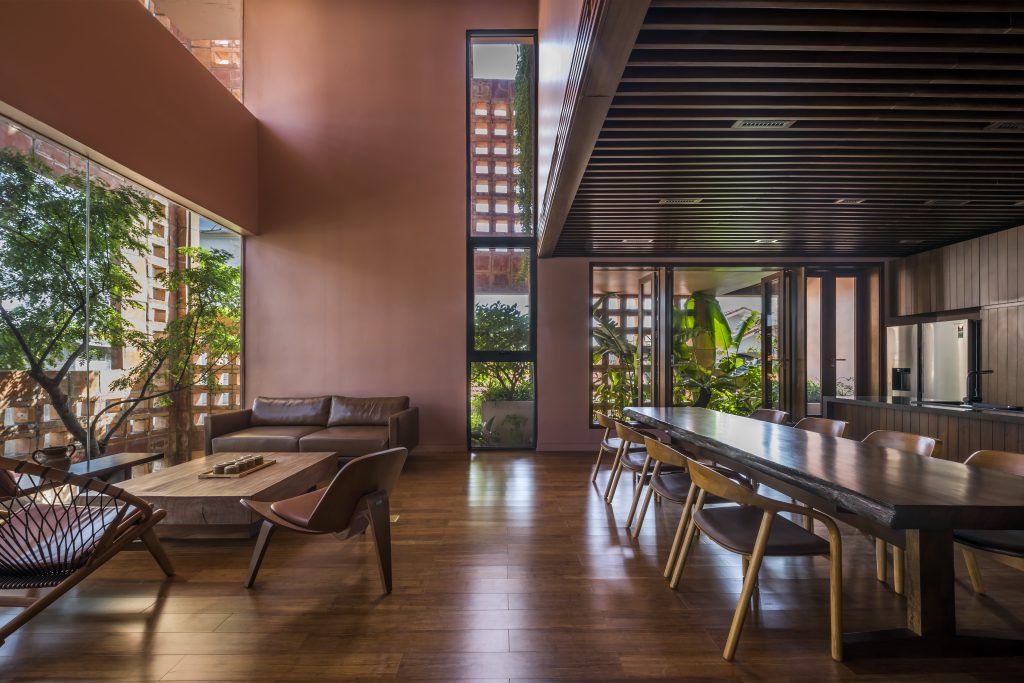
The architect takes inspiration from Bat Trang’s century-long history of ceramic production and the back- ground of the house’s owner whose family has been running a ceramic business for generations.
Natural materials and trees have always been given outstanding roles in almost every work that Vo Trong Nghia Architects has created through the course of their career, as seen with residential projects in particular, including the acclaimed House of Trees series. While bamboo is one of his most favored materials of choice and used with different construction methods for various projects, Bat Trang is, however, the first project that the Vietnamese architecture firm uses ceramic for the building’s skin. The house is situated in an area called Bat Trang Village in Vietnam, fifteen kilometers from Hanoi’s city center. The architecture team takes inspiration from Bat Trang’s century-long history of ceramic production and the background of the house’s owner whose family has been running a ceramic exporting business to Japan and Europe for generations. The result is the design of a unique-looking house and an intelligent way it has found to coexist with the city and nature.
Shophouses are omnipresent in Southeast Asian towns and cities for their spatial functionality that integrates commercial and living spaces into one building. Most shophouses are commonly designed for commercial activities to take place at the front of the building’s ground floor, which is clearly separated from the living quarters. Nevertheless, this type of building in Vietnam often comes with a floor plan where floor levels are used to divide the two functional spaces, which is the kind of architectural program that can be dated back to the 19th Century. From the owner’s brief, the ground and underground floor of Bat Trang House would be used as the showroom for the products from the family’s business. The remaining four floors above are designed into the living quarter, comprising five bedrooms, a kitchen, restrooms, and the living spaces for the seven members of the family with the rooftop housing an outdoor pool and a room where ancestral shrines are placed.
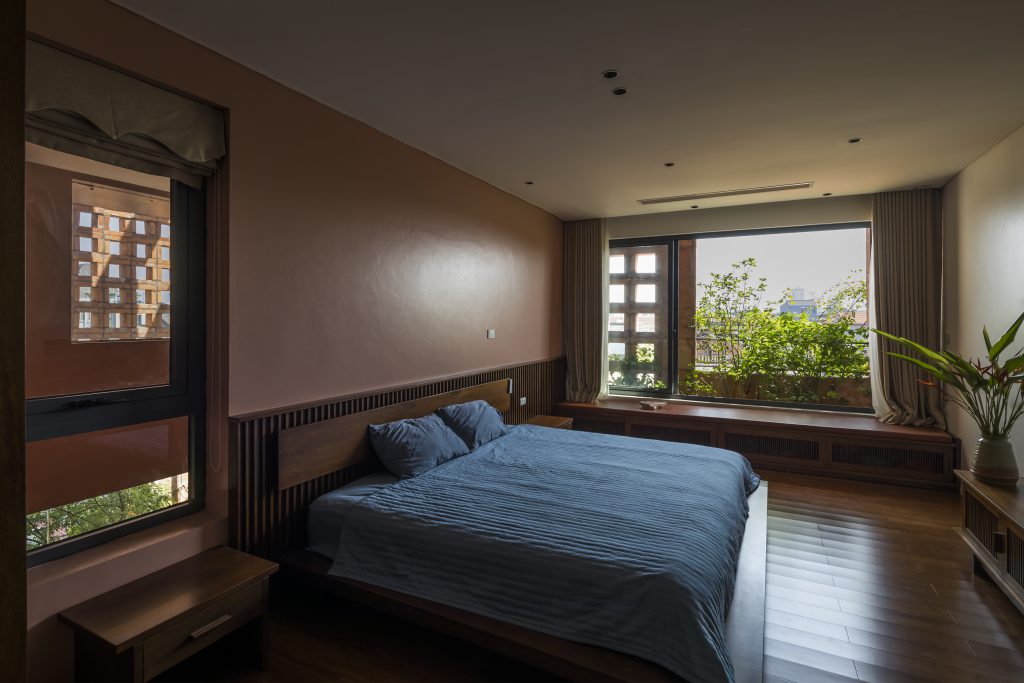
One of the must-haves in Vo Trong Nghia’s architectural signature is a facilitated connection between humans’ living experiences and nature, which reveals itself in the form of spaces where real trees and plants are grown, assimilating the green elements as an inseparable attribute of the house. Fortunately, Bat Trang House is one of the projects where both the architect and owner share the same adoration for green space. While most of his works originate from the same core principle, Vo Trong Nghia Architects has taken a different approach to how each project is designed. One of the houses in the House for Trees series such as Stacking Green (2011) sees layers of growing trees superimposed and shown as the building’s skin while Pot Plant House (2014) in Ho Chi Minh, which is built on a limited plot of land, conceives structures that look like a bunch of oversized bamboo plant pots with trees growing on the roof. For this shophouse in Bat Trang, Vo Trong Nghia Architects takes a similar approach to what they did with Ha Long Villa completed earlier in the same year with the presence of green spaces between the building shell and boundary of the interior living spaces. What sets the two projects apart, however, are details of the functional program and materials used for the building envelopes.
The elevated, vertical gardens found at different levels of Bat Trang House are designed to fit in the spaces between the house and exterior ceramic walls, constructed as its shell whose major role is to protect the interior from sunlight and outside weather. The design of this particular part of the house reflects the project’s local context since all the ceramic tiles are custom-made by a local ceramic maker in the village. The varying sizes of the tiles create a unique-looking shell that renders interesting effects when constructed into the walls, including the openings created at different functional spaces of the house. The shell’s physical attributes facilitate interactions between the spaces inside and outside of the building; between the private residence and the city and community it’s a part of, at different levels. On top of everything, ceramic, as a construction material, offers high durability, with colors and textural details that bespeak natural, raw beauty.
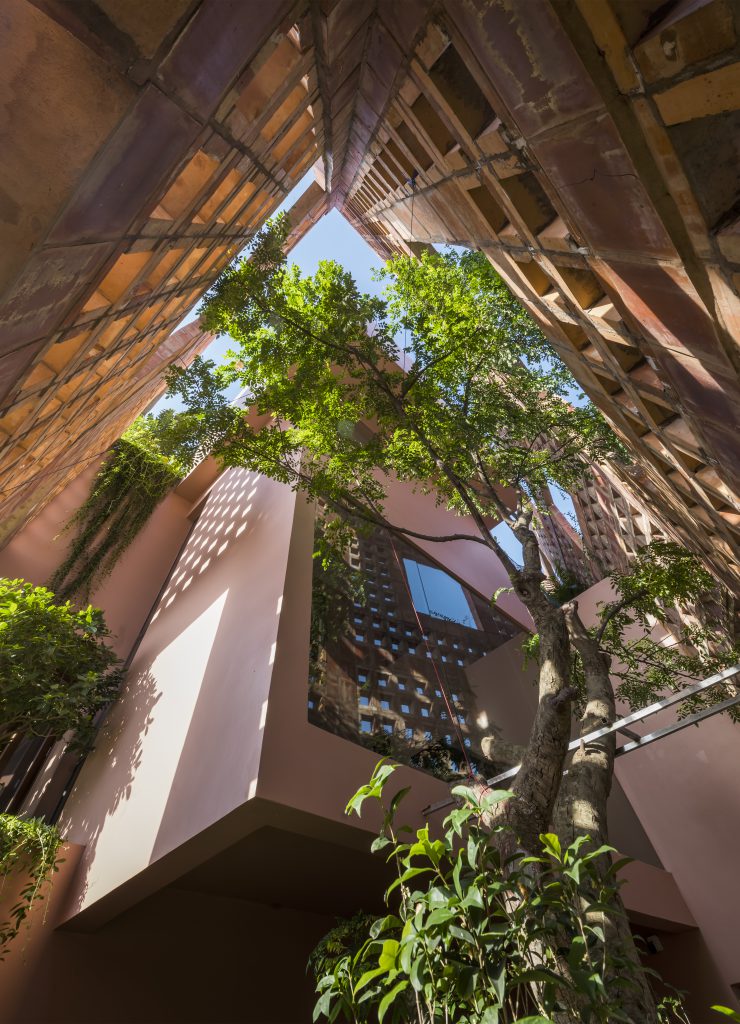
The architecture team’s intent of incorporating passive design results in natural light and wind finding their ways into the building’s interior, creating the right level of thermal comfort while simultaneously lessening energy usage. Just like the studio’s previous works, the house’s floor plan is designed with an appreciation for simplicity. Large glass panels are brought in to frame the interior spaces without having to worry about the high temperature of the living spaces. A direct exposure to sunlight is filtered by the exterior walls, and the green spaces occupying the vertical void work particularly well as a natural filter that keeps natural light in the right amount for the interior spaces, especially over the summer. With this, the air conditioning system becomes almost unnecessary since the architect designs a triple-story ventilation system by alternating the ‘exterior ceramic walls’ with the ‘vertical garden space’ and ‘doors.’ Together they create a frame for the interior functional spaces, ensuring that the house’s temperature is at a comfortably cool level. Solar cell panels and a rainwater storage space have also been added for a sustainable energy reuse.
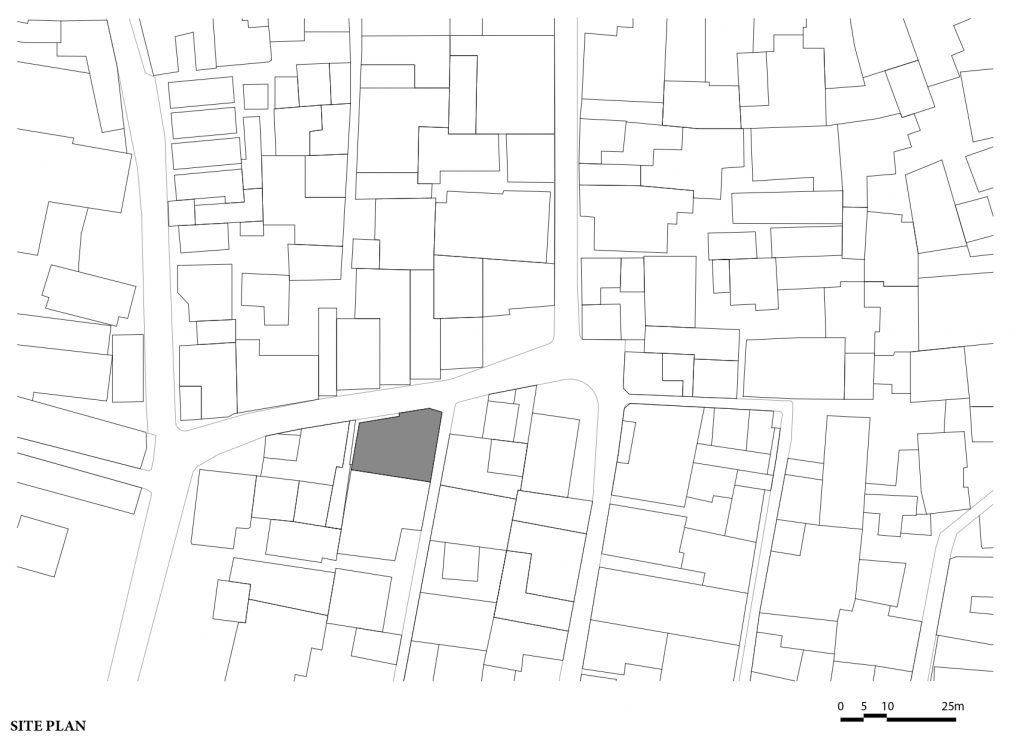
Sizeable windows and openings created by the connected parts of the ceramic walls along with a nice presence of an indoor garden create layers of living frames, varied at different parts of the interior functional spaces by constant changes of natural light and ambiance. These architectural components also bring privacy to the living spaces and inhabitants while adding something new to the neighborhood. The shophouse’s simplistic architectural form, when met with vertical garden spaces and a new application of local materials, becomes a lovely urban home. A close connection between humans, nature and architecture has always play a vital role in Vo Trong Nghia Architects’ architectural practice. They work to create a discernible presence of fresh greenery to the surrounding urban environment, making it a part of inhabitants’ living experiences. In addition to curating users’ experiences through thoughtful interior functional programs, Vo Trong Nghia Architects intends for their architecture to help increase the green space ratio in the dense urban areas of Vietnam, with the hope to improve people’s quality of life and mental well-being. This is and has always been the vision and identity of Vo Trong Nghia Architects whose goals and attempts include using architecture to build new relationships where humans can coexist with nature and the world. This shophouse in Bat Trang is brilliant for its use of materials and building shell design that does its job in showcasing the owner’s business while reflecting the old city’s artistic, cultural and commercial heritage through the ordinary architecture of a shophouse. All of these things were achieved without the need for a pricey LED billboard or a monument at one of the town’s roundabouts to help promote or tell a story.


